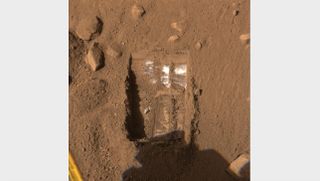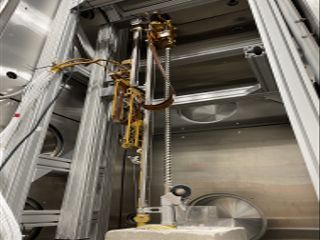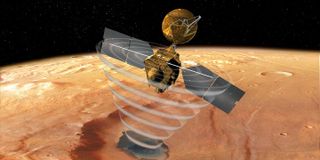NASA's Mars Life Explorer mission would dig deep to hunt for Red Planet life
If approved by NASA, the life-hunting mission could launch in the 2030s.

Has life ever existed on Mars? Could it still exist there today?
These questions intrigue scientists and the public alike. And digging into them could require exactly that — going underground on Mars.
That's what one potential NASA mission, called the Mars Life Explorer (MLE), would do. The deep-digging MLE, which would focus on search for signs of currently existing Red Planet life, received a hearty endorsement from the most recent planetary science decadal survey, a report by the U.S. National Academies of Sciences, Engineering and Medicine that was released in April.
Planetary science decadal surveys lay out the top priorities for research in the field over the next 10 years. And looking for life on Mars is near the top of that list.
"Subsequent to the peak-spending phase of the Mars Sample Return mission, the next priority medium-class mission for the Mars Exploration Program should be Mars Life Explorer," the report states.
Related: How Martian microbes could survive in the salty puddles of the Red Planet

Rise to the top
The Mars Life Explorer would be capable of discovering, if they exist, the signatures of extant life in ice formations close to the Red Planet's surface. As envisioned, the lander would drill into that ice, extract samples and analyze them on the spot.
Get the Space.com Newsletter
Breaking space news, the latest updates on rocket launches, skywatching events and more!
MLE could launch in the 2030s, land within a vertical meter (3.3 feet) of Martian mid-latitude ice, drill for samples up to 6.5 feet (2 m) underground and study those samples on location.
"The NASA Mars program has been very successful. It's a scientific success story," said Philip Christensen, professor in the School of Earth and Space Exploration at Arizona State University, and co-chair of the National Academies' steering committee for the decadal survey.
That decadal study recommended undertaking the MLE mission, an effort that "rose to the top" when the panel looked at mission concept studies, Christensen told Space.com. "The mission made the most sense to the decadal committee," he said.
"I think looking at 'modern ice' on Mars is a very logical thing to do after sample return," Christensen added.
Scientists say that the MLE lander could perhaps operate in parallel with the sample return initiative, a joint NASA-European Space Agency campaign that aims to haul samples collected by NASA's Perseverance Mars rover to Earth in 2033.
Science champion
One of the chief science champions for MLE is Amy Williams, an assistant professor in geological sciences at the University of Florida in Gainesville.
NASA has come a long way since its first serious hunt for extant Mars life, which was conducted by the Viking 1 and Viking 2 landers in the late 1970s and early 1980s, Williams said.
"Since the days of Viking, we've invested in Mars exploration that allowed us to build a robust understanding of the Martian environment, both past and present," Williams told Space.com.
For example, NASA's Sojourner rover demonstrated in the 1990s that remote science could be conducted with a robotic wheeled vehicle, she said.
Then there were the Mars Exploration Rovers, Spirit and Opportunity, which searched for and found robust evidence for water on Mars in the ancient past, Williams added. And those robots' successors have continued to move the research forward.
"The Curiosity rover searched for and found evidence of habitable environments where the core requirements for life as we know it were present — water, carbon and a chemical energy source for metabolism — and now the Perseverance rover is searching for evidence of ancient life in the delta deposits of Jezero Crater," she said.
Also making serious contributions to our evolving understanding of Mars were NASA's Phoenix lander, which found water ice and perchlorates near the planet's north pole, and the agency's marsquake-hunting InSight lander, Williams noted.
Mars missions: A brief history

Probe deeper
"Since the time of Viking, we've made so many discoveries both on Earth and Mars that inform our expectations and challenges for life beyond Earth. The ability to sequence microbial genetic material wasn't even an option until the 1980s, and it would be a powerful technique in the search for life beyond Earth," said Williams.
"On Mars, we've learned that an uncommon salt, perchlorate, is present in enough abundance and physical distribution in the Martian soil to impact one of the ways that we detect organic molecules — with pyrolysis gas chromatography mass spectrometry," she added.
And, thanks to the ongoing work by Curiosity and Perseverance, Williams said, "we now have confirmation that the shallow — less than 6 centimeters [2.4 inches] — subsurface environment can be surprisingly different from the surface rock, increasing our interest in probing deeper into the Martian subsurface."
Lastly, there is a question of how humans on Mars will impact the local environment, including the microbial environment, said Williams. "Of course, avoiding the forward contamination of Mars is a huge priority, but sending a mission like MLE prior to the arrival of humans is preferred to increase our confidence in any and all of the mission's findings," she said.
Ice mining
The MLE's drill system is led by Honeybee Robotics and is based on the company's The Regolith and Ice Drill for Exploration of New Terrains (TRIDENT) design. TRIDENT is an ice-mining drill under development for two NASA moon exploration missions, the Volatiles Investigating Polar Exploration Rover (VIPER) and the Polar Resources Ice Mining Experiment (PRIME1).
The MLE mission is designed to be accomplished in Mars spring and summer in the mid-latitudes.
"The technology is ready now, and presumably there will be technology and engineering developments of this and other drill systems such that improvements to the system may be available by the time MLE would launch in the late 2030s," explained Williams.

The water-ice story
Clearly, getting to underground ice is central for MLE. The story of ice on Mars has unquestionably evolved over the years.
"It's important to remember that there was a time when we didn't have confirmation of water ice in the Martian subsurface," Williams said. "Those first images from Phoenix digging into the regolith and seeing ice that then sublimated were inspiring!"
Scientists' understanding of the Mars water-ice story has also been advanced by observations by NASA's Mars Reconnaissance Orbiter (MRO) and the Thermal Emission Imaging System instrument onboard the Mars Odyssey spacecraft.
For example, MRO carries a Shallow Subsurface Radar instrument (SHARAD), which was provided by the Italian Space Agency. SHARAD "pings" the Mars landscape in search of a strong radar return wave. A good bounce-back may indicate the presence of underground liquid or frozen water.
"We now have increased confidence that we can land a stationary spacecraft in a location with water ice within 1 meter [3.3 feet] of the surface," said Williams.
The beauty of mission concept studies like MLE, Williams said, is that they are just that — a study of a particular idea. There's the ability to devise alternative ideas where the spacecraft could touch down to increase confidence in a select landing site, "as well as in the payload we send," she said, "to address this most fundamental question: Are we alone in the universe?"
Leonard David is author of the book "Moon Rush: The New Space Race," published by National Geographic in May 2019. A longtime writer for Space.com, David has been reporting on the space industry for more than five decades. Follow us on Twitter @Spacedotcom or on Facebook.
Join our Space Forums to keep talking space on the latest missions, night sky and more! And if you have a news tip, correction or comment, let us know at: community@space.com.

Leonard David is an award-winning space journalist who has been reporting on space activities for more than 50 years. Currently writing as Space.com's Space Insider Columnist among his other projects, Leonard has authored numerous books on space exploration, Mars missions and more, with his latest being "Moon Rush: The New Space Race" published in 2019 by National Geographic. He also wrote "Mars: Our Future on the Red Planet" released in 2016 by National Geographic. Leonard has served as a correspondent for SpaceNews, Scientific American and Aerospace America for the AIAA. He was received many awards, including the first Ordway Award for Sustained Excellence in Spaceflight History in 2015 at the AAS Wernher von Braun Memorial Symposium. You can find out Leonard's latest project at his website and on Twitter.
